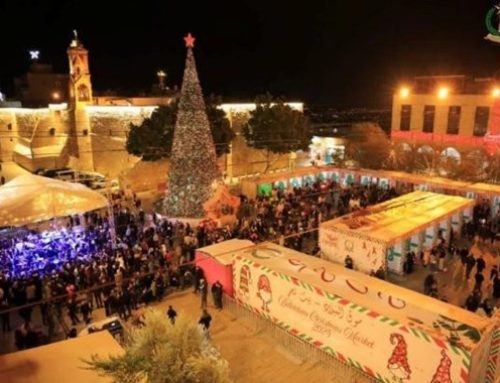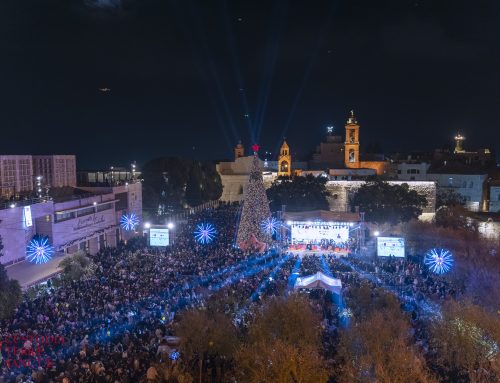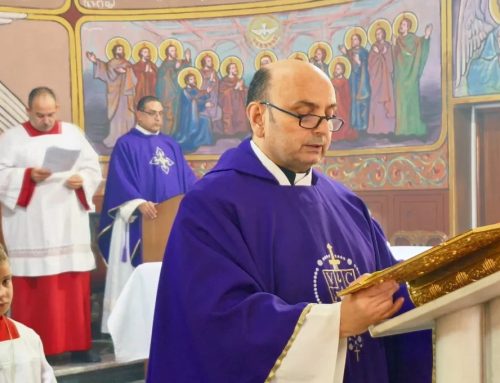“You like it? Well, you bought it.”
We are standing on an overlook at Bethlehem University. I am admiring a sweeping highway bridge across an expansive valley. My Palestinian guide, Sami El-Yousef, explains that the distant highway, essentially a road to allow Israelis to bypass the checkpoints of the Palestinian territory, where Bethlehem is, was paid for by U.S. dollars.
For the first time, on my first-ever trip to Israel, I understand that, as a U.S. taxpayer, I really influence what happens here, the place where “Middle East peace” isn’t happening. The lives of real people, many of whom are Christian, are in the balance. Sami is one of them.
Meeting Sami El-Yousef might challenge most Americans’ notions of Palestinians. We hear of Islamic fundamentalist terrorists, dressed in garb foreign to us, throwing rocks, speaking the language of another place. Sami is a 50-year-old educator, graduated from UMass-Amherst and University of Pittsburgh as an industrial engineer. He later spent some years in California.
He is Orthodox Christian, from the “other lung of the Church,” as Pope John Paul II called it. As we walk together through the streets of Old City Jerusalem, his home, he is dressed in “business casual” (short-sleeved shirt and tie). He speaks English.
At this point in life, Sami, whose family goes back generations in Jerusalem, has moved from academia to the front lines in developing his country. He left his 24-year career as teacher, dean, then vice president for finances and planning at Bethlehem University to work for the Pontifical Mission Society. Known here as Catholic Near East Welfare Association, the society provides financial support for Catholic projects in the Middle East, northeast Africa, India and Eastern Europe.
Sami serves as regional director for Palestine and Israel. The Jerusalem office is basically next door to his childhood home.
Late last year, in preparation for Pope Benedict’s Special Synod of Bishops for the Middle East, he served as a guide for a group of journalists from American Catholic publications, including St. Anthony Messenger.
A Man From Jerusalem
During our weeklong journalists’ immersion, Sami, former professor that he is, would educate us from Jerusalem to the West Bank, to Haifa on the Mediterranean coast and back again. Along the way we would learn about modern-day Israel from a Christian, Catholic point of view. Much of our trip was spent in the West Bank region, which, we learned, is far more than the bank of the River Jordan.
The West Bank, to Palestinians, is simply part of Palestine. In biblical times it was Judea, Samaria and part of Jerusalem. It covers about 2,300 square miles and is home to about two million people. It has changed hands a lot in recent decades.
In an interview with St. Anthony Messenger, Sami illustrates the point with a little family history. His family, among the oldest in Jerusalem, goes back 400 years. “My grandfather was born in the late 1800s in East Jerusalem, which at that time was in the Ottoman[Turkish] Empire.” His grandfather’s birth certificate was Turkish.
“My father’s birth certificate reflects Palestine, under the British Mandate.” When Sami was born, Jerusalem was under Jordanian rule, he explains, so he has a Jordanian birth certificate. “When my four children were born, we were under Israeli rule, so their birth certificates reflect that.”
It was his children who prompted Sami and his wife of 26 years, Irene, to leave Jerusalem after the first modern Palestinian revolt (intifada), which lasted from 1987 to 1993. As violence escalated, schools shut down.
“If there is any legacy I want to leave for my children, it is a good education,” he says. He had lived in the United States two different times for his own college education. He and Irene, who is from Bethlehem, decided to join family members in California for the children’s sake. They became part of the growing Palestinian diaspora.
In 1993, after the Oslo Peace Talks pointed so promisingly to peace in the Middle East, Sami persuaded his wife to move back to Jerusalem. They reoccupied their home in the Old City, which they had left furnished and under the protection of nearby family—clearly they had intended to come back.
His children enrolled at St. George’s parish school nearby, and his family continued to grow. Two of his four children were born after their return (the two older ones are in colleges in the United States).
His children’s experience can hardly compare to his own. When he was very young, in the early 1960s, Sami recalls, under Jordanian rule the children of East Jerusalem lived a relaxed life. “Sometimes we would climb the wall of our school, on the border of East and West Jerusalem, to look at the Orthodox Jews with their hats, with their long hair and so on.”
In his predominantly Muslim neighborhood, everyone got along “in a brotherly manner. We would go to their houses for the iftar meal at the end of Ramadan; they would exchange gifts with us at Christmas. There were Jewish neighbors here and there—everyone got along,” says Sami. None of them had any idea that the Jewish neighborhoods from across the wall would, after 1967, be in their midst.
Sami’s children now live under the palpable tension of military occupation. Sami has to verify his residency with written proof of work, utility bills, birth certificates, reasons for traveling
and more. In any event he has to do so annually, and also every time he leaves the country, registers a ewborn, renews his driver’s license, and so on.
He also has to provide documentation constantly about where his children go to school, which doctors he sees (they must be in Jerusalem)—“a dossier of documents.” But, unlike most Palestinians, he can travel freely within Israel. Those who live outside of Jerusalem are not allowed to leave their region—either the West Bank or Gaza—without Israeli-issued permits, which are sometimes arbitrary and always hard to get.&
Pressure to Leave
Today Sami lives in a city that is, inch by inch, being occupied by Jewish Israelis. “Especially with the current right-wing government,” he says. “They’ve made Jerusalem, particularly East Jerusalem, a priority.” As far as settlement activity goes, that is, building apartments or houses to populate new
territory, East Jerusalem used to be offlimits. “The trend, especially during the past two years, has been to settle in Palestinian neighborhoods.” In November, for example, Israel approved 1,000 new Jewish homes in East Jerusalem.
The local government determines, says Sami, “either legally or illegally,” that the property, perhaps 100 years ago, belonged to a Jewish family. “Either by going to court or not going to court, the property is confiscated.”
Our journalists’ group witnessed this firsthand from the roof of a Franciscan school in the Old City, as soldiers inspected a nearby apartment. Walking in the Old City, we also couldn’t help but notice ubiquitous security cameras.
“They [the Israeli army] know everything about who comes and goes, and what they are doing.” It’s all a bit stifling, and all done in the name of security, says Sami, “but that’s not really the case.” In his widely held opinion, it’s as much about putting pressure on the Palestinian community as anything.
In spite of that, Jerusalem is worth living in, he says. “You feel really so privileged, to be born and have family here, to live so close to the Holy Sepulcher, to walk the streets that Jesus once walked.” He can hear his heartbeat every time he describes it. He wants his grandchildren to be born here.
Hassled Bethlehem
In the heart of Palestine lies Bethlehem, a place close to the heart of all Christians. Bethlehem University, operated by the Christian Brothers, strives to mold leaders for a future Palestinian nation. It was on the edge of campus that Sami and I had gazed at the highway bridge across the valley.
The university—despite periods of open war—has graduated about 11,000 students since its inception in 1973. A group of students met with us during our visit.
Nagib Kasbary lives in Bethlehem. Typical of college students most anywhere, he’d like to go to the beach. After all, the Mediterranean shore is little more than an hour’s drive west of Bethlehem—if there weren’t checkpoints. But it would take so much hassle to go to that area, he says, that it’s not worth it.
“It’s not only the beaches,” says Rita Asfour. She’d like to visit the sacred places of Jerusalem, but can’t get a permit required to leave the West Bank. She talks of further trouble she has for living “what’s supposed to be a half an hour away.” Like all students who live farther than a stone’s throw away, she is required to live in the dormitories during the week. “It takes me an hour and a half” because of the military checkpoints, she says. “So I go back and forth each weekend.” 
This is the case for students from nearby Ramallah, from Jerusalem and “for the students from all over Palestine.”
Christina Jueejat, from Bethlehem, chimes in, telling the woes of local students. “For an 8 a.m. class, we need to leave at 6 in the morning, and if there are a lot of checkpoints, we get here at noon, missing class altogether.”
There are more hassles besides merely being stopped. The students report arbitrary behavior on the part of the checkpoint soldiers. “If he is happy, he will just let me go,” says Nagib. “If he is in a bad mood, he will try to get me in a bad mood, too.”
Rita adds, “Sometimes, when they are really bored, they just make you wait, for hours.” Or they subtly harass attractive young women: “Sometimes they make you take off your belt, your earrings—they won’t let you pass until they’re done with that ‘fun part.’”
When asked if these might be legitimate security concerns, she sums up her frustration: “Why would an Israeli want to put a checkpoint between two Palestinian places, and start humiliating people?”
Beer in the Land of Jesus
“Nothing is going to get better in Palestine without a strong local economy.” So says David C. Khoury, mayor of Taybeh, the last exclusively Christian village in Palestine. Taybeh is in the West Bank, perhaps 20 miles north of Bethlehem. In biblical times Taybeh was known as Ephraim, the village where Jesus stayed to prepare for his final Passover in Jerusalem (see John 11:54).
Mayor Khoury had picked up the brewing trade when he emigrated to Boston to raise his family years ago. His father persuaded him to return to Palestine to start a business. Taybeh microbrewery, the only one in the region, has become a point of cultural pride for Palestinians everywhere.
“Taste the Revolution,” Khoury’s ads proclaim. Taybeh’s annual Oktoberfest, unlikely as it may seem in these dry hills, is a growing regional event. It features Palestinian-made products and a place to “dance and sing as if no one is watching!”
On a wall in the small brewery, one sees a map of the commercial checkpoints that limit David’s business. But he is a determined man: “We Christians still have the land because our great-grandfathers did not sell it,” he had told us an hour earlier, in the mayor’s office. “I feel that this is a treasure, a Christian town, and we have all the right to keep it that way.”
He has made a special program of preserving the homes in Taybeh’s old city, some of which date at least to the 17th century. There are infrastructure projects, too, some funded by programs abroad. Driving across town, as he points out his various improvement programs throughout the town—a park here, a restaurant there—one gets the idea that he means business.
Dr. Mariah C. Khoury, David’s wife and business partner, walks our group through the ancient ruins of St. George’s Church, at the highest point in Taybeh. She points to Jewish settlements on distant, surrounding hills that look like anything but the primitive encampments conjured by the word settlement. Israeli settlements are closer to what we Americans might call gated suburban communities. And even in this dry land, their residents stay comfortable.
“We in Taybeh get water for only two days per week,” Mariah says, “and other towns may get water only one day. At the settlements, it’s 24/7.” That makes brewing beer a challenge.
A Franciscan Tradition
Back in Jerusalem, a little more than a block from Sami El-Yousef’s family home, is Terra Sancta School, established—no kidding—in 1645. Franciscans have been in the Holy Land for a long time.
They first were entrusted with care of the Christian sacred sites in the 14th century, decades after St. Francis impressed his selfless sincerity upon Saladin, the Kurdish conquerer. That Sufi Muslim, eventually respected even by the Crusaders whom he had ousted, had occupied much of the Middle East, including Jerusalem. The sites sacred to the heart of Christianity have been in the care of the Franciscans ever since.
Tucked just inside the walls of Jerusalem’s Old City, Terra Sancta, an elementary school, today serves a critical role in the local Christian Palestinian culture. Getting schoolbooks sensitive to Palestinian culture is an issue, says the school’s director, Simon Herro, O.F.M.
His onetime teacher, now the school’s secretary (principal), Yousef Naswari, suggests that the petty obstacles are a way “to evacuate Arab citizens from Jerusalem.” He offers the example of the wall isolating the Old City from the suburbs, thus damaging the local Palestinian economy: “You need permission to come and go from Jerusalem,” he says, “and the permission is not given.” The examples keep coming.
The Franciscans, who live in a large friary in the center of Jerusalem’s Christian Quarter, would like to expand the school, but can’t, because the Israeli government won’t permit it. This is another example, says Simon, of the Israeli government’s quiet campaign to occupy Jerusalem further. The government also takes possession of empty houses when Palestinians yield to the smothering confines of the occupied city and leave.
Friar Simon speaks of the parish he serves not far from here: “Our parish in 1967 [the time of the Six-Day War, Israel’s takeover of East Jerusalem, including the Old City] was 15,000. Now we are less than 5,200!”
The stifling pressure is just too much, he says. “I will stay, and my family will stay,” he adds. But many of his cousins and friends have moved to Jordan, beyond the disputed post-1967 boundaries, or to Europe, the United States or elsewhere.
Do these school leaders think peace is possible in the Middle East? “I am not optimistic,” Yousef says, and Friar Simon sadly nods in agreement. For example, says Simon, a few years ago Terra Sancta set up a peace exchange with a school in Tel Aviv. Terra Sancta brought their students to the Israeli school much as any school might take a field trip. “But when they came here, they brought soldiers to protect them.” He holds his hands as if they are balancing scales, with one hand pulled a bit lower. “See the difference?”
Mary of Nazareth ‘Come Home!’
When Elias Chacour was a child, just after World War II, he witnessed the arrival to his village of Jewish troops from the newly formed Israel. A state for Palestinians was promised, too. But things turned out differently.
In the following years, the Palestinians were treated as insignificant people, some would say like animals, by the Israeli army. In his autobiography, Blood Brothers, Chacour tells firsthand how the people of his village were forced out of their homes into the woods, and how, within a year, the army came with bulldozers and flattened Biram, where his farming family had lived for generations.
Over a million Palestinians ended up in seven United Nations refugee camps, which persist to this day, grown into makeshift cities (we visited one). The rest, like Chacour’s family, wandering the Jordan River unable to find refuge, rebuilt new lives one inch at a time, closer to home.
Even in the midst of that strife, back in Galilee, Chacour felt a calling to the priesthood. Elias Chacour, now the Melkite Catholic archbishop of Akka, Haifa, Nazareth, all of Galilee, is a pacifist—thrice-nominated for the Nobel Peace Prize. He is deeply concerned, though, that Christians are being run out of the Holy Land.
Just before speaking at the pope’s Special Synod of Bishops for the Middle East, at the Vatican, he speaks to our group of journalists in Haifa. He talks of peace in the Middle East, of justice for Palestinians and of his meeting with Israel’s prime minister. He had told then-Prime Minister Ariel Sharon that Biram is something he will never quit talking about. Then he, clearly a man of good humor, says, “I hear people from here tell me of trips to Fatima, to Lourdes, and they ask me if they can bring me something. I tell them, ‘You tell that lady from Nazareth to come home! We need her here!’”
On a more serious note, later in our conversation, he says, “We don’t need more cruelty; we need a committed friend. Go in peace back home to tell what you have seen.” His words remind me of another man from Galilee.






